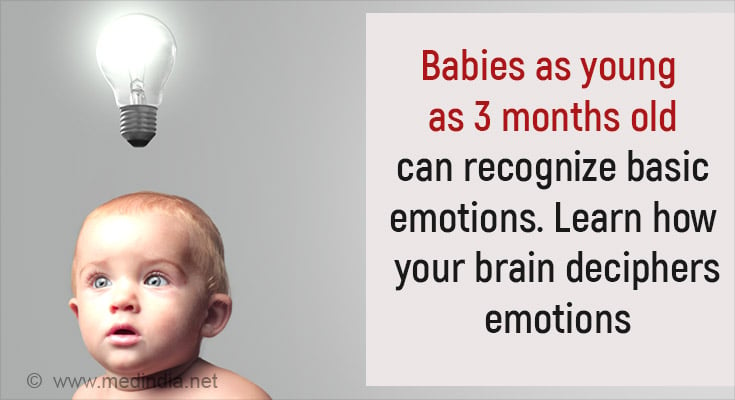- Emotional recognition is essential for social interaction and survival in both humans and animals
- The prefrontal cortex and retrosplenial cortex form a crucial brain circuit for processing emotional stimuli
- Disruptions in this circuitry are linked to deficits in emotional recognition seen in psychiatric disorders
Understanding how the brain recognizes emotions is a captivating journey into the intricate workings of the human mind. Emotions serve as the vibrant palette through which we experience and navigate the world, influencing our thoughts, behaviors, and interactions. From the joy of a shared laugh to the sting of a heartfelt goodbye, emotions color every aspect of our lives. Yet, behind these rich experiences lies a complex neural symphony orchestrated by the brain (1✔ ✔Trusted Source
Our Emotional Brains: Both Sides Process the Language of Feelings, With the Left Side Labeling the “What” and the Right Side Processing the “How”
).
Within 100 milliseconds, your brain can recognize an emotion on someone’s face – even before you consciously see it. #brainpower #emotionscience #medindia’
Advertisement
The Importance of Emotional Recognition
Recognizing and responding to the emotions of others is not just a social nicety; it’s a fundamental aspect of human interaction deeply ingrained in our biology. From animals forming packs to humans navigating complex social structures, the ability to understand and appropriately react to the emotions of those around us is critical for survival and thriving within communities.
Furthermore, emotional recognition plays a central role in effective communication. Beyond words, much of our communication relies on non-verbal cues such as facial expressions, body language, and vocal tone. Being able to accurately interpret these cues allows us to discern the underlying emotions behind someone’s words, enhancing our understanding of their intentions, desires, and needs (2✔ ✔Trusted Source
How Does Your Brain Process Emotions? Answer Could Help Address Loneliness Epidemic
Advertisement
The Brain Circuit In Emotional Recognition
The research has identified a specific brain circuit that plays a pivotal role in recognizing others’ emotions. This circuit consists of interconnected regions within the brain that work together to process and interpret emotional information from sensory inputs which consists of neuronal cells that connect two distant brain regions: the prefrontal cortex and the retrosplenial cortex.
- One key region involved in the brain circuit for emotional recognition is the prefrontal cortex. Situated at the front of the brain, the prefrontal cortex is associated with higher-order cognitive functions, including decision-making, social behavior, and emotional regulation.
It helps to integrate incoming sensory information, such as facial expressions or vocal cues, with stored knowledge and past experiences to decipher the emotional state of others. - Another critical component of the emotional recognition circuit is the retrosplenial cortex, located in the posterior part of the brain. The retrosplenial cortex is involved in various cognitive processes, including spatial navigation, memory, and self-referential processing.
It plays a role in integrating emotional information with spatial and contextual cues, allowing us to make sense of others’ emotions within the broader context of our environment.
These two regions are interconnected via a network of neuronal pathways, facilitating communication and information exchange between them.
Studies using advanced neuroimaging techniques, such as functional magnetic resonance imaging (fMRI), have provided evidence of coordinated activity between the prefrontal cortex and the retrosplenial cortex during tasks involving emotional recognition.
This synchronized activity suggests that these brain regions work together as part of a larger circuit to process and respond to emotional stimuli.
Advertisement
Emotional Recognition Deficits in Psychiatric and Neurodevelopmental Disorders
Moreover, research has shown that disruptions or abnormalities in this brain circuit can lead to difficulties in emotional recognition and social functioning.
For example, individuals with certain psychiatric or neurodevelopmental disorders, such as schizophrenia or autism spectrum disorder, often exhibit deficits in recognizing and interpreting the emotions of others. Understanding the neural basis of these impairments can inform the development of targeted interventions and therapies aimed at restoring normal functioning of the emotional recognition circuit.
In Summary, the discovery of a specific brain circuit responsible for emotional recognition marks a significant advancement in neuroscience. Through coordinated activity between regions like the prefrontal cortex and retrosplenial cortex, we gain insight into how the brain processes and responds to emotional stimuli.
Understanding these mechanisms not only deepens our comprehension of human social interaction but also holds promise for developing targeted interventions for psychiatric and neurodevelopmental disorders. As we continue to solve the complexities of the emotional recognition circuitry, we move closer to unlocking new avenues for therapeutic interventions and enhancing our understanding of the human brain.
References:
- Our Emotional Brains: Both Sides Process the Language of Feelings, With the Left Side Labeling the “What” and the Right Side Processing the “How”
– (https://www.apa.org/news/press/releases/2003/01/emotional-brains) - How Does Your Brain Process Emotions? Answer Could Help Address Loneliness Epidemic
– (https://health.ucsd.edu/news/press-releases/2021-03-05-how-does-your-brain-process-emotions-answer-could-help-address-loneliness-epidemic/)
Source-Medindia



